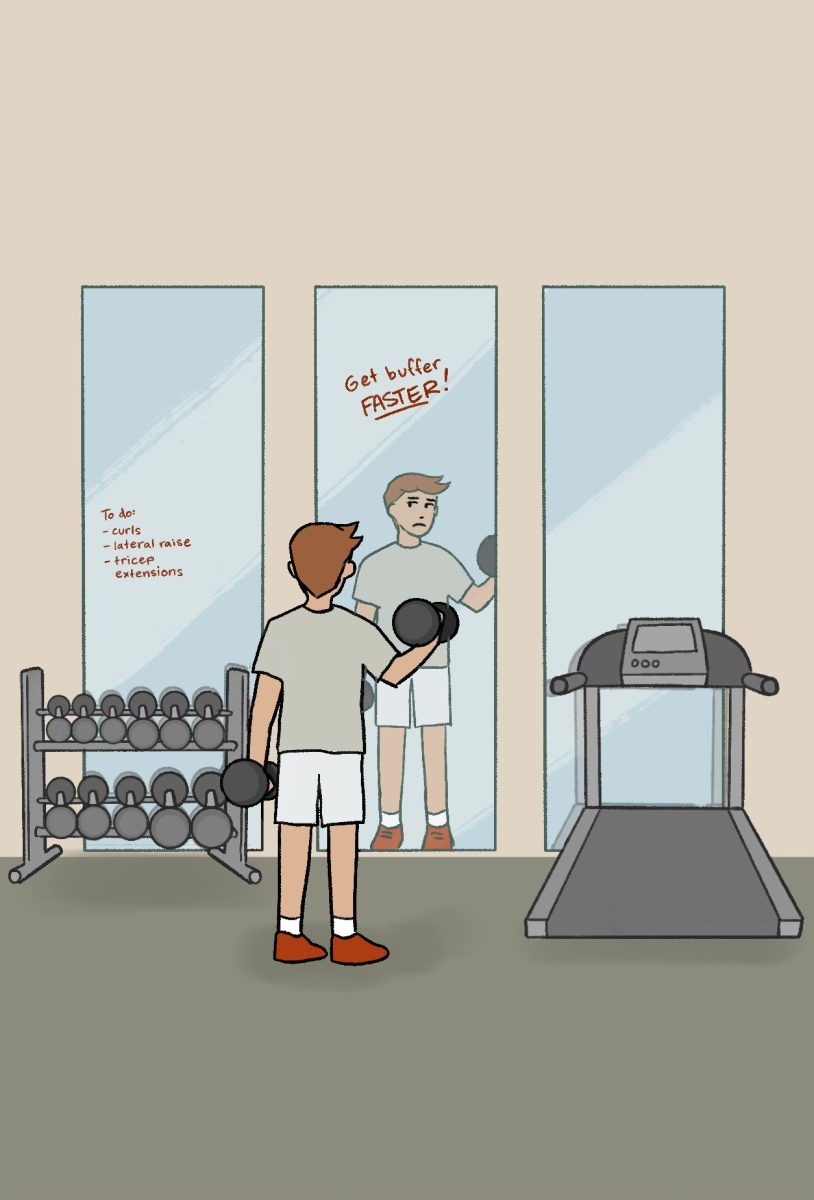By Lydia Gugsa
Procrastinating while doing his homework on a Friday night, Finn Slootweg ’26 was scrolling through social media when he came across a post titled “How to Get Buffer and Faster,” where a man was seen working through an intense fitness routine, lifting dumbbells and running on a treadmill. Although Slootweg scrolled past, the video lingered in his mind, causing him to wonder why his social media feed would suggest it to him. Slootweg said the pressure to conform to a certain body type, especially coming from social media, can push men to adopt extreme diets or workouts to fit a specific image of masculinity.
“My experience with social media is that it feeds you a lot of people that you want to look like or that you idealize,” Slootweg said. “Most men want to feed into societal norms and look super muscular, masculine and built. Social media will feed them a lot of men who look like that. It forces them to feel a sense of urgency to try and change their body.”
Body image is a combination of the thoughts and feelings that you have about your body, according to the National Eating Disorders Collaboration. This can include feelings of satisfaction or dissatisfaction with their physical appearance. A positive body image can lead to confidence and self-acceptance, while a negative body image may result in feelings of shame or insecurity. Accord ing to the National Library of Medicine, one study found that the percentage of men dissatisfied with their overall appearance has nearly tripled to 43% in the past 25 years, and that nearly as many men as women are unhappy with how they look.
Sports Psychologist Kat Scardino said it is dangerous to compare one’s body to others’ due to the unrealistic standards set by social media.
“You don’t see everything that goes into what someone does for their body,” Scardino said. “We can manipulate a photo, even a video. Everybody’s genetics are different. What may look good to one person is not the same. In a lot of those workout routines, they don’t actually show what they do. And so when you try it, and it doesn’t work, it feels like, ‘Oh my God, why am I doing all of these workouts? If I’m not doing as well as they are, I must be a bad athlete.’ ”
Varsity football player and wrestler Jasiri Johnson ’27 said the physical and mental toll associated with one’s perception of their body image can vary between team and individual sports.
“If you underperform in your sport, for example, one-on-one sports like wrestling or track, it does take a toll on your body,” Johnson said. “For team sports, like basketball, volleyball and football, you have your team to rely on. Since you’re all working together, it doesn’t feel like anything is completely on you. For individualized sports, it’s a lot more on your body than it is when you’re on a team. When it’s more on you, it feels like you’re not up to standard of being able to run fast enough, or pick up your opponent. Underperforming in a solo sport can give you a reality check of where you think you’re supposed to be because that person might be or look stronger, faster and better than you at the sport, and you feel as though your body cannot handle the pressure of that sport.”
Slootweg, a transgender man, said gender dysphoria, distress from a mismatch between gender identity and assigned sex at birth, plays a huge role in body image for transgender people.
“Specifically, when you’re a transgender person, people have a certain vision for what you should look like if you’re going to pass as like that gender,” Slootweg said. “Therefore, I think that a lot of transgender people have a harder time with their body image, and also dysphoria in general. A lot of times with gender dysphoria, it can make you feel that you need to look a certain way because society thinks that you’re only trans if you look a specific way. Not all trans people feel as big of a need to pass like other trans people and that plays a really big, part in their body image issues amongst trans people because society has an image of what a trans person like, and what a trans man needs to look like.”
An article from The Cut, a digital magazine by New York Magazine, emphasizes how social media, especially TikTok, has been promoting prod ucts to show men, especially teenagers, how to take care of their body. Scardino said a fixed mindset can lead to unhealthy habits and a distorted view of fitness.
“I’ve worked with male athletes who, when they feel a certain way about their body, may feel more confident going out to perform,” Scardino said. “If you’re feeling really strong, you might feel stronger out there to perform, but there is a healthy and a very unhealthy way of those two things having a relationship.”
Slootweg said that although others might feel pressure to conform to standards of masculinity, he would rather do what makes himself happy.
“I’m a pretty self sufficient person,” Slootweg said. “I don’t necessarily care a lot about what other people’s opinions of me are. I mean, I do care to a point, but not deeply. For me, it’s more about how I feel, and I don’t think that the way that society feels, or what society deems is acceptable or the norm really affects me as much as it affects other people, because at the end of the day, I would rather be happy and be me than be sad and conformed to what other people think I should be.”
Callum MacLachlan ’26 said not having to pay as much attention to how his body looks has allowed him to feel more confident in himself.
“I love my body,” MacLachlan said. “I used to feel pretty bad about my body in seventh grade, but now that I’m on the other side, having a positive body image definitely adds confidence. I’m a very loud guy, and if I’m worried about people judging me, I’m mostly worried about them judging me for my personality, not for my looks. It led to be a lot more outrageous, while a lot of other people would have to fit into society more and fit into norms.”
A study from the Newport Institute, a mental health treatment center for young adults and teens, showed that after viewing images of physically fit men, men perceived themselves as weaker, less attractive and in worse shape than they previously thought they were.
Slootweg said unrealistic masculine ideals harms both men’s bodies and their emotional well-being.
“Masculinity pushes the idea that men are supposed to think that they’re supposed to be able to gain all this muscle, but in reality, it’s really a small percentage of people who are able to do that,” Slootweg said. “So, the fact that society makes them feel that they’re not allowed to think about that is the reason why some develop mental health issues.”
Up to 2.4% of the male adult population who suffer from body image also suffer from body dysmorphic disorder (BDD), according to The Recovery Village, a rehab center that treats addiction and mental health issues. BDD is a mental health condition where a person becomes excessively preoccupied with perceived flaws or defects in their physical appearance, even if those flaws are minor or not noticeable to others. In some cases, BDD can lead to eating disorders. Slootweg said he feels that a lot of male fitness culture contributes to eating disorders.
“A lot of times, men will use the phrase ‘Oh, I need to go on a cut,’ as something more than that,” Slootweg said. “In actual gym culture, cutting would be eating enough protein or cutting down on carbohydrates. But a lot of times, men, when they say they’re going on the cut, they really mean that they’re just not eating. I think that they use this term as a way to try and trick themselves into thinking that they’re contributing to this masculine idea when instead, they’re really harming their body.”
Scardino said appearances in sports can be misleading, and it’s more important to focus on what works for one’s own body.
“We don’t actually know if a person is training ten times or ten hours a day, or not eating and not fueling themselves, or if they’re bulking up, or if they’re using performance enhancers,” Scardino said. “It’s just very distorted. Figuring out what works for your body and your sport and makes you a good human and a good athlete is the most important thing.”





























